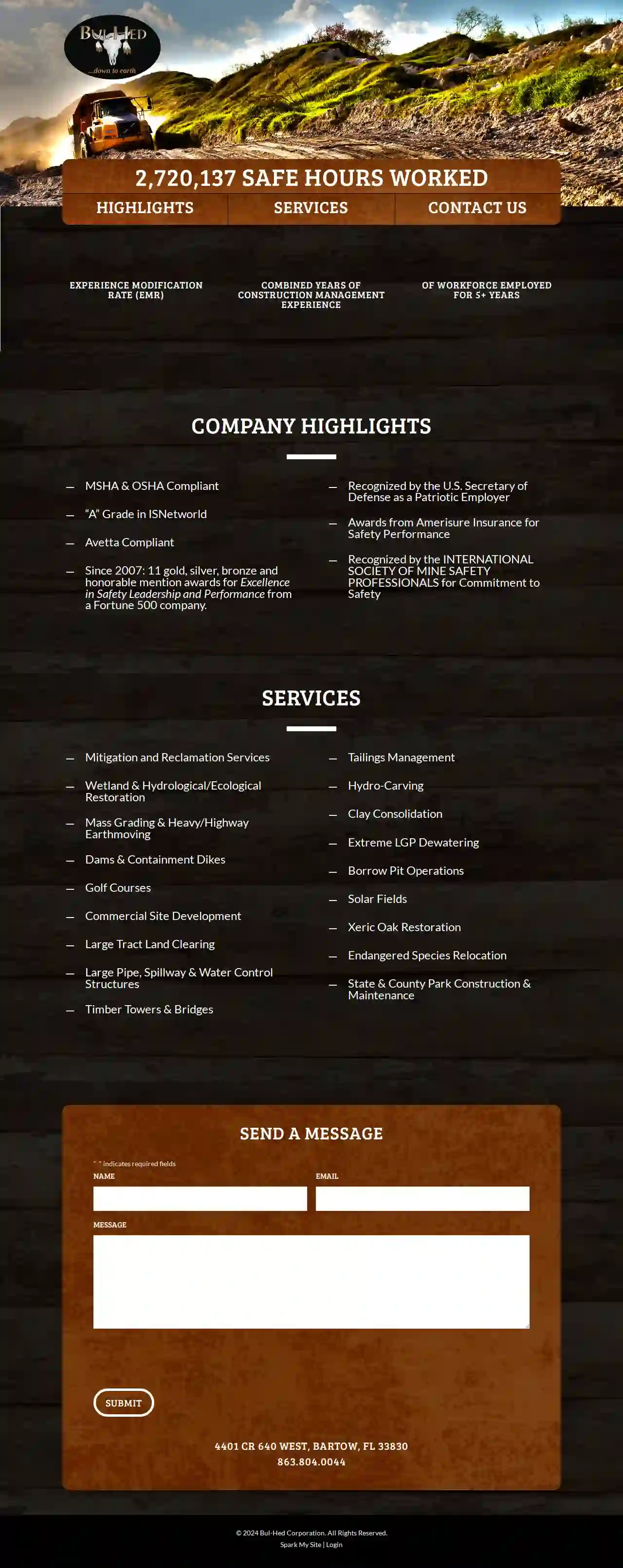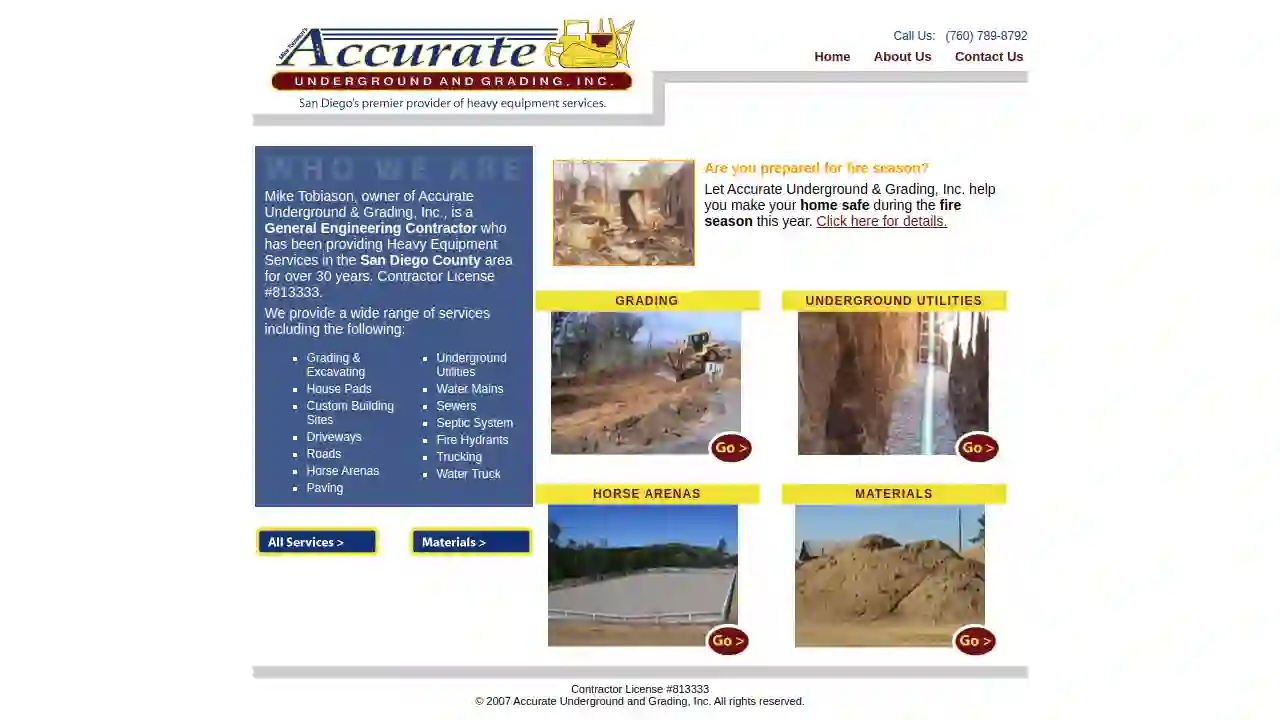Demolition Contractors Covina
Find the best Demolition Contractors Near Me in Covina
Get up to 3 Building Demolition quotes for your project today! Compare profiles, reviews, accreditations, portfolio, etc... and choose the best deal.

Bul Hed Corporation
511 reviews4401 CR 640 West, Bartow, 33830, US2,720,137 Safe Hours Worked Bul-Hed Corporation is a leading provider of environmental construction and reclamation services. We have a proven track record of success in delivering high-quality, safe, and environmentally responsible projects. Our team of experienced professionals is committed to exceeding our clients' expectations and delivering projects on time and within budget. Company Highlights MSHA & OSHA Compliant “A” Grade in ISNetworld Avetta Compliant Since 2007: 11 gold, silver, bronze and honorable mention awards for Excellence in Safety Leadership and Performance from a Fortune 500 company. Recognized by the U.S. Secretary of Defense as a Patriotic Employer Awards from Amerisure Insurance for Safety Performance Recognized by the INTERNATIONAL SOCIETY OF MINE SAFETY PROFESSIONALS for Commitment to Safety
- Services
- Why Us?
- Gallery
Get Quote
Niehaus Earthmoving LLC
51 reviewsOakland, USOur Company At Niehaus Earthmoving LLC, our mission is to provide top-quality earthwork services that exceed our clients' expectations. We strive to deliver projects on time, within budget, and to the highest standards of safety and quality. Our Experience With over 15 years of experience in the mass-excavation and grading industry, our team has the skills and expertise to handle any job, no matter how complex. We've worked on projects start to finish ranging from city streets to large-scale commercial developments, Ag production facilities, wind/solar farms, landfills, wetland restorations, river diversions, waste management lagoons, heavy highway and interstate construction. Our Services We offer a comprehensive range of earthwork and demolition services including site preparation, excavation, grading, and compaction. We also provide dust control, erosion control, and slope stabilization measures to ensure the longevity of your project. " We Move The Earth " Initiation - Planning - Execution We are able to provide efficient and cost-effective grading services to ensure your project is completed on time, on budget and to your satisfaction. We provide expertise in, in-house site design such as building sites, drainage, and roads. We can meet any vigorous project scheduling demands. Contact us today to discuss your project needs and receive an estimate.
- Services
- Why Us?
- Our Team
- Gallery
Get Quote
Edri Construction
4.851 reviews701 Cortland Ave, San Francisco, 94110, USYour Trusted Construction Partner: Excellence from Demolition to Finishes People are looking for a reputable and reliable contractor. It does indeed represent us, but what sets us apart is the ability to be attentive to the customer and guide him patiently, from the demolition stages to the impeccable finishes, with professionalism as the common thread between each and every stage. We handle even the most complex projects entirely in-house, utilizing our own team of experts and advanced equipment. This practice allows us to accurately budget every project, ensuring transparency and efficiency throughout the process. Thanks to our satisfied customers, our growth is largely fueled by referrals. We strive to maintain this momentum by consistently exceeding expectations and delivering exceptional results. At Edri Construction, we bring expertise, reliability, and a commitment to excellence to every project we undertake.
- Services
- Why Us?
- Gallery
Get Quote
A-1 Septic Services
4.675 reviewsModesto, USThe Best Value in Septic Tank Services in Merced County, Stanislaus County, and San Joaquin County Since 1990 The Best Value in Grading & Excavating in Merced County, Stanislaus County, and San Joaquin County Since 1990 Best Choice for Portable Restroom Rentals in Merced County, Stanislaus County, & San Joaquin County Expert Septic Tank Services, Grading & Excavating in Modesto, Oakdale, Escalon & Surrounding Areas For the best septic tank installation and repair, septic tank pumping, utility trenching, and grading/excavation services in Merced County, Stanislaus County, and San Joaquin County, choose A-1 Septic and AAA Backhoe Service. For over 30 years, we've been the preferred septic tank company and excavator for thousands of general contractors, builders, commercial businesses, property managers, city agencies, homeowners, and real estate agents. They trust us because we consistently deliver high quality workmanship and personalized customer service at very competitive prices. Whether you need septic tank repair in Modesto, leach line additions in Ceres, or utility trenching in Salida, we have the skills, knowledge, and expertise to get the job done according to the highest industry standards. AAA Backhoe Service holds a Class A General Engineering Contractors License from the California State License Board, and has earned an A+ rating with the Better Business Bureau. We always use the industry's best practices to ensure that all work gets completed on time, in budget, and in accordance with county and city building codes.
- Services
- Why Us?
- Accreditations
- Testimonials
- Gallery
Get Quote
Eagle Asphalt - Asphalt & Paving Contractor
4.920 reviews4721 W. Jennifer Ave., #14, 4721 W. Jennifer Ave. #14, Fresno, 93722, USEagle Asphalt CA Eagle Asphalt proudly offers a wide range of services, we are your one-stop pavement and asphalt solution! Whether it be an asphalt overlay, new asphalt construction, or asphalt repair, Eagle Asphalt in Fresno, California has the experience and expertise to see the job through from start to finish. Give us a call… today! Eagle Asphalt in Fresno, CA is Locally Owned, Licensed & Insured. Serving Central Valley.
- Services
- Why Us?
- Our Team
- Testimonials
- Gallery
Get Quote
A.P. Thomas Construction, Inc.
52 reviews2330 Butano Drive, Sacramento, 95825, USIt’s a Great Day to Build! With A.P. Thomas Construction, Inc., an award-winning company based in the Sacramento area, you’ll recognize a company that rivals larger firms in capabilities and value, yet gives personal attention and commitment to you and your investment. For more than two decades, we’ve delivered innovation, diversity and quality to commercial projects throughout Northern California.
- Services
- Why Us?
- Gallery
Get Quote
Optimal EarthWork
51 reviews3070 Garden Ave, San Jose, 95111, USTransforming Landscapes with Precision: Earthworks Experts We harness the raw potential of the earth to create extraordinary transformations and deliver awe-inspiring results for every project we undertake. Excavation & Grading Swimming Pool Demolition Demolition
- Services
- Why Us?
- Accreditations
- Our Team
- Testimonials
- Gallery
Get Quote
Cascade Environmental
51 reviews22722 29th Drive SE, Ste 228, Bothell, 98021, USWho We Are Cascade Environmental is a field services contractor that partners with our clients to provide seamless environmental and geotechnical solutions, from concept to completion. Over the last 25+ years, Cascade has grown from a Northwest US regional drilling company into a national, full service organization offering innovative solutions for every step of your project. Mission To contribute to a sustainable future through environmental investigation and restoration. Vision To be the premier company that leverages safety, employee expertise, technology, and sustainability to continuously outperform our competition in the infrastructure and environmental remediation industry. Core Values We believe in providing a workplace free of recognized hazards for the safety, health and well-being of our employees and clients. We believe in growing our business in a responsible manner through significant investment in our people, our company, and our communities. We believe in exceeding expectations in everything we do. We believe in working together to achieve goals thru integrity, accountability, and trust. CASCADE ENVIRONMENTAL® Cascade Environmental is the leading field services provider of environmental and geotechnical drilling, site investigation, and remediation. We offer the full suite of drilling technologies including sonic, auger, rotary, and direct push. Our crews are experienced in traditional and high resolution site characterization technologies for groundwater sampling and analysis, contaminant mass and distribution, and other in situ data for detailed and accurate conceptual site models. We also offer a line of injectable amendments designed to help you reach site closure faster and cost-effectively. Who We Are Our experts understand the importance of accurate sampling regardless of geologic conditions. Whether a discrete or representative sample is needed, Cascade has the tools and technologies to obtain it. Our experienced crews can obtain samples from soil, rock and even the most difficult subsurface conditions. Cascade offers a full range of environmental drilling and sampling services for nearly any application. We conduct soil, soil gas, and groundwater sampling, including discrete and representative sampling, vertical aquifer profiling, and bedrock coring.
- Services
- Why Us?
- Gallery
Get Quote
E&F Construction Services
4.73 reviews851 TRESTLE GLEN RD, Oakland, 94610, USAbout E&F Construction E&F Construction was founded in 2004 by Tony Elenteny, who brought years of experience from his family's construction company. In 2015, Paul Hollenbach, with over 15 years of experience running his own construction company, joined forces with Tony. Together, they combined their expertise to create a construction company with over 35 years of experience in general contracting and project management. Their areas of expertise include seismic retrofits, high-end kitchen and bath renovations, whole home remodels, foundation and structural repairs, and light commercial tenant improvements and HOA projects throughout the East Bay. At E&F Construction, they take pride in their exceptional customer service, responsiveness, and clear communication throughout every stage of a project. Whether you have plans ready or are just starting to consider changes to your home or business, their skilled, clean, and thorough crews are available to meet your needs efficiently and within budget. Personally supervised by Tony and Paul, every E&F crew consistently demonstrates meticulous attention to detail, design aesthetics, efficient use of space, timeliness, and respect for your property. E&F Construction understands that making significant aesthetic or structural changes to your home or business is a complex process with many moving parts and a high potential for costly errors. They believe that when done right, improvements can add lasting value, increasing your ROI, satisfaction, and enjoyment of the space. Whether you're looking to earthquake-proof your building, add a master suite, or give your entire home a refresh, your time, money, and project deserve the skilled workmanship, effective project management, and trustworthiness that E&F Construction represents. Don't let your dream project turn into a nightmare. Let E&F Construction handle all your construction needs now and in the future. They care about you and your project! Check us out on Yelp.
- Services
- Why Us?
- Our Team
- Gallery
Get Quote
Accurate Underground & Grading
51 reviews1315 Walnut Street, Ramona, 92065, USAbout Us Accurate Underground & Grading, Inc. is a family-owned and operated business that has been serving the San Diego County area for over 30 years. Owner Mike Tobiason is a General Engineering Contractor with over 30 years of experience in the industry. Mike was born and raised in Ramona and started working with his father Angus at a young age. He learned the trade from the ground up, operating equipment and installing septic systems. In 1982, Mike started his own business, Accurate Underground & Grading, Inc. Since then, the company has grown into a thriving mid-sized excavating company, providing a wide range of services to residential and commercial clients. Our Commitment to the Community Accurate Underground & Grading, Inc. is committed to giving back to the community. We support many different community events, including the Ramona Boys & Girls Club, Grad-Nite, the Ramona Jr. Fair & Livestock Auction, Ramona Pony Baseball, Ramona Girls Softball, Poway Girls Softball, the Ramona 4th of July Fireworks, and the Ramona Lutheran School Playground. Our Team Mike and his team are dedicated to providing high-quality services to their clients. They are committed to safety, efficiency, and customer satisfaction. Accurate Underground & Grading, Inc. is a company that you can trust to get the job done right.
- Services
- Why Us?
- Our Team
- Gallery
Get Quote
Over 22,076+ Excavation Contractors onboarded
Our excavation experts operate in Covina and beyond!
ExcavationHQ has curated and vetted the Best Excavation Companies arround Covina. Find a top & trustworthy pro today.
Frequently Asked Questions About Demolition Contractors
- Waste Generation: Demolition generates a large volume of debris, contributing to landfill space and potentially releasing harmful substances into the environment if not disposed of properly.
- Air Pollution: Dust and particulate matter released during demolition can impact air quality, affecting human health and the environment.
- Noise Pollution: Demolition activities can generate significant noise, disturbing nearby residents and wildlife.
- Resource Depletion: Demolition consumes resources that could be salvaged and reused, contributing to resource depletion and environmental degradation.
- Size and Complexity of the Structure: Larger and more complex structures, such as multi-story buildings, require more time, labor, and specialized equipment, increasing costs.
- Type of Demolition: Different demolition methods, such as implosion, wrecking ball, or high-reach demolition, have varying costs.
- Material Disposal: Disposal fees for demolition debris can contribute significantly to the overall cost, depending on the type and quantity of materials.
- Location and Accessibility: Demolition in densely populated areas or with limited access may require more planning and specialized equipment, affecting costs.
- Hazardous Materials: The presence of asbestos, lead paint, or other hazardous materials requires specialized removal and disposal procedures, adding to the expenses.
What is the difference between demolition and deconstruction?
Demolition: Typically involves bringing down a structure quickly and efficiently, often using heavy machinery and potentially explosives. The primary goal is to clear the site.
Deconstruction: Focuses on carefully dismantling a building piece by piece to salvage reusable materials. It prioritizes minimizing waste and environmental impact, often involving manual labor and specialized tools.
The choice between demolition and deconstruction depends on the project's objectives, budget, and environmental considerations.
What are the environmental impacts of demolition?
How much does demolition cost in the USA?
Can I do demolition myself?
What is the difference between demolition and deconstruction?
Demolition: Typically involves bringing down a structure quickly and efficiently, often using heavy machinery and potentially explosives. The primary goal is to clear the site.
Deconstruction: Focuses on carefully dismantling a building piece by piece to salvage reusable materials. It prioritizes minimizing waste and environmental impact, often involving manual labor and specialized tools.
The choice between demolition and deconstruction depends on the project's objectives, budget, and environmental considerations.
What are the environmental impacts of demolition?
- Waste Generation: Demolition generates a large volume of debris, contributing to landfill space and potentially releasing harmful substances into the environment if not disposed of properly.
- Air Pollution: Dust and particulate matter released during demolition can impact air quality, affecting human health and the environment.
- Noise Pollution: Demolition activities can generate significant noise, disturbing nearby residents and wildlife.
- Resource Depletion: Demolition consumes resources that could be salvaged and reused, contributing to resource depletion and environmental degradation.
How much does demolition cost in the USA?
- Size and Complexity of the Structure: Larger and more complex structures, such as multi-story buildings, require more time, labor, and specialized equipment, increasing costs.
- Type of Demolition: Different demolition methods, such as implosion, wrecking ball, or high-reach demolition, have varying costs.
- Material Disposal: Disposal fees for demolition debris can contribute significantly to the overall cost, depending on the type and quantity of materials.
- Location and Accessibility: Demolition in densely populated areas or with limited access may require more planning and specialized equipment, affecting costs.
- Hazardous Materials: The presence of asbestos, lead paint, or other hazardous materials requires specialized removal and disposal procedures, adding to the expenses.